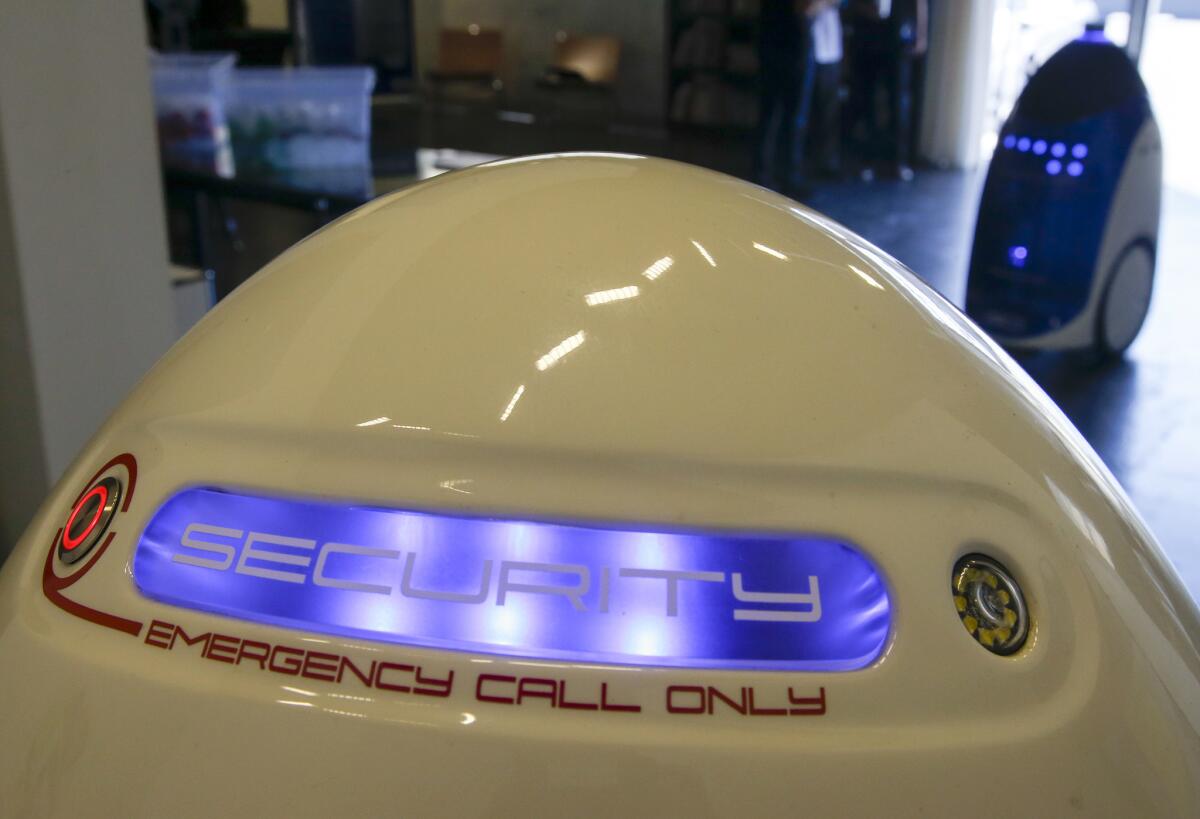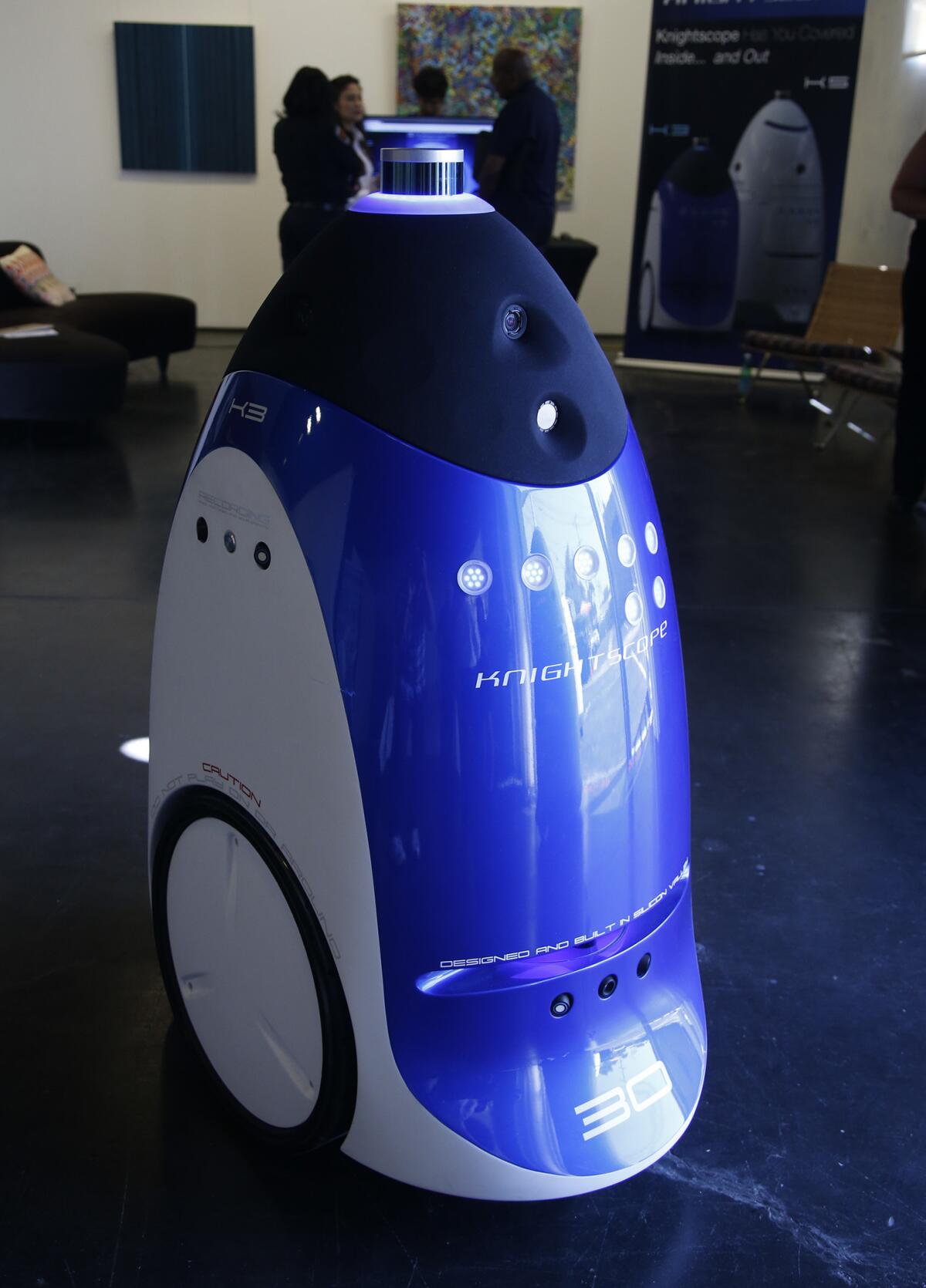Robots are becoming security guards. ‘Once it gets arms ... it’ll replace all of us’

Knightscope security robots demonstrated at the Jamie Brooks Fine Art Gallery in Costa Mesa August 17, 2016. Besides playing a security role in retail malls, the robots could also be used for inventory control and other safety purposes.
William Santana Li imagines a future where robots will keep Americans safe.
Communities, he dreams, will take security into their own hands by investing in wheeled machines that patrol streets, sidewalks and schools — instantly alerting residents via a mobile app of intruders or criminal behavior.
“What if we could crowd-source security?” said Li, co-founder and chief executive of a robotics company, Knightscope, that hopes to eventually do just that.
His question is like many posed by Silicon Valley entrepreneurs seeking to modernize, privatize and monetize services once entrusted to the government — and it’s one that has intrigued venture capitalists who have pumped $14 million into his start-up.
Already, Knightscope robots are edging into the private security industry, patrolling parking lots, a shopping center and corporate campuses in California. The company’s ambitions, though, are much bigger.
Knightscope manufactures two robots — the five-foot tall K5 and the four-foot K3. Both weigh a hefty 300 pounds (they were designed to make it hard to tip over). Customers such as the Stanford Shopping Center, Qualcomm and Uber rent them starting at about $7 an hour (Knightscope, based in Mountain View, Calif., charges more if companies want extra services, such as more than two weeks of data storage).
The robots — which resemble a cross between R2D2 and a Dalek from “Doctor Who” — can record, stream, send and store video; provide thermal imaging; read license plates; track parked cars; serve as a two-way intercom; play a pre-recorded message; and detect humans in places they’re not supposed to be.
It’s going to turn the security guard and security industry into super humans
— Knightscope co-founder and CEO William Santana Li
With sensors and lasers, they build a three-dimensional map of their environment that lets them navigate without bumping into anything. Every couple of hours, they find their charging pad and top off their energy during a “coffee break,” Li said.
The robots have not yet led to any arrests, though their presence has sparked some unusual human behavior (Li said some have come back from patrols with lipstick marks). The company drew headlines after a K5 knocked down a toddler and ran over his foot at the Stanford Shopping Center in July. Li declined to comment on the collision, pointing to a company news release that apologized and called the incident “the freakish accident.”
Despite the bumpy start, Knightscope robots have become something of a poster child for a burgeoning sector of service robotics — a fast-growing industry that seeks to break robots free from the factories where they have been confined for decades and release them into the broader world to assist their human creators.
The lure of robots has tantalized Silicon Valley entrepreneurs and investors. Funding for robotics start-ups hit $587 million last year, up 115% from $273 million in 2014, according to CB Insights.
See the most-read stories in Business this hour »
“We are seeing a record growth of business start-ups that are developing robots,” said Andra Keay, managing director of Silicon Valley Robotics, a nonprofit group that supports these start-ups. “There was a separation between areas that can be automated and areas that can’t — that is changing.”
Many start-ups are seeking to give robots routine tasks requiring the kind of repetition that often leads to human error. Simbe Robotics, based in San Francisco, has Tally, which can audit store inventory aisle by aisle. Savioke, a Silicon Valley firm, has the butler robot Relay, which delivers towels, toothpaste and Starbucks drinks to hotel guests.
It is the world of security, though, where the potential and pitfalls of robotics are perhaps most apparent. Already, Knightscope customers are using robots to patrol parking lots — keeping an eye on cars and acting as a deterrent against speeding drivers. Others are serving as roving security cameras that can roll to possible trouble spots in sprawling corporate campuses. By renting the robots by the hour, many companies, especially those that need around-the-clock security, could save money over time.
Corporate clients are Knightscope’s primary business, but Li and co-founder Stacy Dean Stephens — a bespectacled former cop from Texas who left law enforcement more than a decade ago to dive into the start-up world — see a bigger market for their 3-year-old firm.

They say they have already had meetings with public agencies such as the Department of Homeland Security and several airports, including LAX. But they also believe robots could pave the way for the public itself to get involved in detecting and catching wrongdoers — before, during and after a crime.
When neighborhoods start investing in security robots, locals would be notified on their mobile devices when something suspicious is afoot, Li said. Many homeowner associations have already inquired about renting one.
“If there is a machine-detected anomaly — like someone breaking into a car — we’re going to push a yellow or red alert to everyone nearby in the community,” he said. “Instead of see something, say something, what about see something, do something?”
Eventually, residents will be able to submit tips via an app, Stephens said. The identities of terrorists, such as the brothers behind the Boston Marathon bombing, could be uncovered more quickly, he said.
“There were thousands and thousands of people who were tweeting, Facebooking, Instagramming, putting all this stuff out on social media,” said Stephens, who serves as vice president of marketing. “If you could find a way to aggregate that data through an app, and have a way to intelligently comb through it, can you imagine how much faster we could have caught those guys?”
But privacy advocates question whether Americans really want robots patrolling their streets and neighbors leading investigations.
“It opens the door to pervasive surveillance in public spaces,” said Marc Rotenberg, executive director of the Electronic Privacy Information Center. “Robots will capture all of the activity around them — not only the guy who is acting suspiciously, but also the young couple holding hands or a guy just walking down the street.”
The questions multiply as robots gain additional skills, such as facial recognition (on which Knightscope is actively working). Customers could, in theory, ask the robots to flag people who don’t live in their neighborhood — potentially leading to racial profiling.
That kind of behavior has already been a problem for other tech companies dabbling in public safety. Nextdoor, a social network for neighbors, has been trying to rein in what critics describe as racial profiling after many postings warned of suspicious characters who just happened to be African American or Latino. On Reddit, a sprawling online message board community, the collective hive mind wrongly accused individuals of being involved in the Boston Marathon bombing.
Li, a former Ford Motors executive with a head of slicked-back hair, shoots down such doubts with a mix of Silicon Valley zeal and well-practiced salesman’s patter. He calls fear about misuse of robots “false logic,” saying that the authorities would rely on more than tips alone to nab criminals.

At a recent demo event in Irvine, several Southern California companies — including hospital chain St. Joseph Health and real estate services firm CBRE — clustered around the K5 and the more petite K3. As the sun beat down, the crowd watched fixated as Jack Schenk, vice president of business development at Knightscope, ran through some of the robots’ less obvious abilities.
“Now, this is controversial,” Schenk said. “Who has their Wi-Fi on right now?”
Almost everyone raised their hands.
“The robot will access your phone and take its unique ID,” he continued. That enables companies, he said, to “white-list and blacklist” mobile devices. If someone appeared on the blacklist — say a fired employee still toting their company phone — the robot would send an alert. A bag containing a phone not on the preapproved list could indicate corporate espionage, Schenk theorized, or even a bomb.
For Li, these kinds of capabilities will complement human security staff, not replace them, by adding to their ability to see, hear and sniff out danger. Robots could even, in his view, up the appeal of mall cop and security guard jobs by giving the profession a high-tech edge.
“It’s going to turn the security guard and security industry into super humans,” he said.
This is not the first time Li and Stephens have made their pitch to the security world.
The pair were co-founders in Carbon Motors Corp., which set out to build high-tech cars for police use. In 2013, the auto company filed for Chapter 7 bankruptcy protection, four years after it moved with much fanfare from Atlanta to Connersville, Ind., with the promise of bringing 1,300 jobs. Instead, Carbon Motors burned through about $7 million in public grants; at the time of its bankruptcy filing, the company owed investors and vendors $21.7 million.
Despite that history, security firms appear eager to work with Li and Stephens’ firm. Industry giants Allied Universal and Securitas plan to supply Knightscope robots to their customers.
Knightscope won’t say how many robots are working now, but it hopes to deploy 50 to 100 robots by the end of the year.
Allied Universal executives acknowledge that robots could be a big cost savings to their clients — and may replace many human guards.
Steve Claton, president of Allied’s southwest security services, said pay starts at around $12 an hour for its guards, but more seasoned workers can pull in $25 and $30 an hour. Off-duty and retired cops earn upwards of $35 an hour. The nation’s 1.1 million security guards earn an average of $13.68 an hour, according to the Bureau of Labor Statistics. That compares with the $10 an hour Allied will charge to rent robots.
“The cost of labor is going up, with the pay raises and healthcare,” Claton said. “We’re at that intersection where it is a viable option to look at replacing a manned position — or augmenting it — with a robot.”
The first jobs to be replaced will be non-sensitive positions, such as the graveyard shift, said Mark McCourt, Allied Universal’s vice president of enterprise services. Eventually, robots could fill positions that he calls “the three Ds” — dull, dangerous and dirty.
“It makes sense to put a robot there,” he said, although some customers still require persuasion, like with any kind of technological advance. “I’m sure people were like, ‘What do we need cars for, we have horses,’” he said with a chuckle.
Rank-and-file security guards are watching the robots with a wary eye.
At the Irvine event, a security guard for the building nodded toward the robots outside: “Here’s my replacement right there.”
“It can’t open doors or pick up packages yet,” the guard said. “Once it gets arms though, it’ll replace all of us.”
MORE BUSINESS NEWS
How I Made It: Jess Lee’s unlikely path to running Polyvore
Chiropractors see diabetes as a chance for new patients — and profit
More to Read
Inside the business of entertainment
The Wide Shot brings you news, analysis and insights on everything from streaming wars to production — and what it all means for the future.
You may occasionally receive promotional content from the Los Angeles Times.










